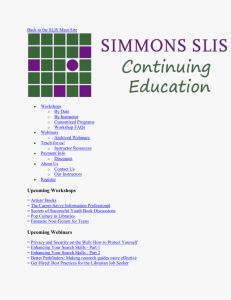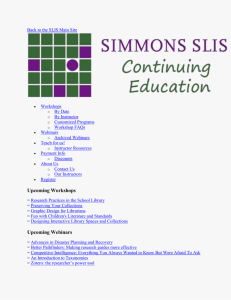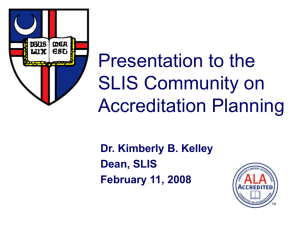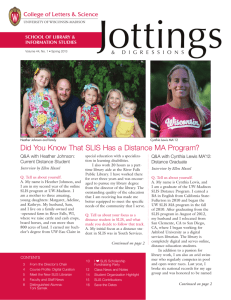DIVERSITY ACTION PLAN MISSION To provide leadership and
advertisement
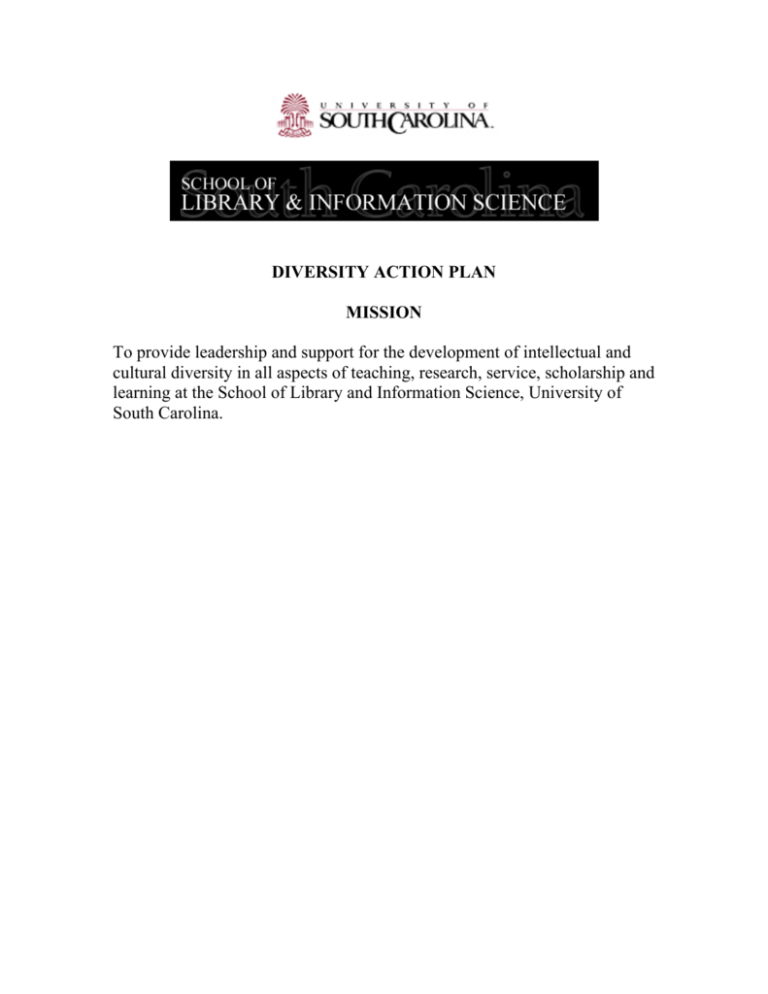
DIVERSITY ACTION PLAN MISSION To provide leadership and support for the development of intellectual and cultural diversity in all aspects of teaching, research, service, scholarship and learning at the School of Library and Information Science, University of South Carolina. STUDENT DIVERSITY ACTION PLAN Immediate Goals 1. Foster an inviting campus environment that respects differences and encourages inclusiveness. 2. Increase the recruitment and retention of diverse students. GOAL 1: Foster an inviting campus environment that respects differences and encourages inclusiveness. Success Indicators: • SLIS students are aware of ongoing diversity planning processes. • SLIS student groups are racially/ethnically diverse. • Agenda of student orientation includes presentations on diversity by campus-wide organizations and by LISSA. • Successful student initiated diversity activities/programs/projects are recognized. • Diversity learning opportunities, beyond the traditional curriculum, are available and ongoing. • Diversity partnerships with outside constituencies (community leaders, local businesses, etc.) are evident. Objective 1 • Students will have an immediate introduction to and continuing reminder of the presence of diversity in their academic and cultural experience at the School of Library and Information Science. o Action Steps At the SLIS new student orientation, offer a presentation on campus-wide organizations that promote diversity. Include available SLIS student diversity programs in the Library and Information Science Student Association’s presentation. Develop diversity meetings/interactive events that engage, on a regular basis, both students and faculty in dialogue on key USC-SLIS diversity issues. Seek assistance and guidance from existing campus diversity resources. 2 Objective 2 • Develop and execute a comprehensive communication plan reflecting diversity. o Action Steps Examine all written and electronic communication materials to ensure that they reflect student diversity. Publicize SLIS diversity events campus-wide and to alumni. Make available, both print and electronic, a calendar of opportunities for participation in campus-wide diversity activities. Objective 3 • Ensure that multicultural awareness and diversity training is available in formal coursework across the curriculum and in informal workshops. o Action Steps Include multicultural issues in all classes. Research successful diversity curriculum efforts incorporated by other institutions of higher education. Offer at least one workshop each semester on diversity. Objective 4 • Build and enhance partnerships with University, community, professional, business and other outside organizations that support and encourage diversity. o Action Steps Form partnerships to deliver diversity training. Bring in speakers from the University and the surrounding community to discuss diversity issues outside of SLIS. Seek internships for students in agencies that encourage diversity. Use professional organizations to provide speakers and materials supporting diversity. Involve the professional community in mentoring students. 3 GOAL 2: Increase the Recruitment and Retention of Diverse Students Success Indicators: • Annual increases in the number of students from under represented groups (racial/ethnic) are evident. • Scholarship opportunities for diverse students increase. • Involvement in SLIS diversity recruitment efforts by the African American Leadership Group is ongoing. • Measured and evaluated diversity recruitment/retention strategies are adopted and implemented. Objective 1 • Develop a student body reflective of the changing demographics of South Carolina and the nation. o Action Steps Reflect diversity in all recruitment and marketing materials for SLIS, both print and electronic. Promote scholarships and financial aid programs that support diversity. Involve the African American Leadership Group and other key alumni in recruiting activities establishing diverse recruitment teams. Schedule the HBCU’s Graduate and Professional School Fairs as a part of SLIS’s annual recruiting efforts. Identify other venues that specifically target ethnic/racial groups for recruiting efforts. Include articles promoting diversity in alumni publications. Form partnerships with K-12 institutions, particularly those serving concentrations of racial/ethnic groups defined as minority populations, to recruit for the undergraduate program. FACULTY/STAFF DIVERSITY ACTION PLAN 4 Immediate Goals 1. Serve as an active and consistent model of leadership excellence for increasing diversity of viewpoints, diversity of backgrounds, including gender and ethnic differences, as well as variety within academic specialties. 2. Build and maintain a diverse community of administrators, faculty, staff and students. 3. Promote opportunities for developing respect for differing ideological perspectives. 4. Create a welcoming, supportive and diverse environment in which all administrators, faculty, staff and students can succeed. 5. Promote and foster a culture of inclusion. 5 GOAL 1: Serve as an active and consistent model of leadership excellence for increasing diversity of viewpoints, diversity of backgrounds, including gender and ethnic differences, as well as variety within academic specialties. Success Indicators: • Equity and Diversity Committees are fully operational. • Faculty and Staff at all levels are involved in improvement processes. • Recognition programs acknowledge diversity leadership models. Objective 1 • Develop partnerships that facilitate diversity recruitment and contribute to the University’s diversity profile. o Action Steps Identify organizations dedicated to advocacy for specific groups. Identify institutions that produce significant numbers of diverse PhD graduates. Present programs at a variety of conferences. Create opportunities for interaction of SLIS faculty and staff with faculty and staff of Historically Black Colleges and Universities (HBCU). • Initiate a faculty exchange program. • Invite diverse adjunct instructors and presenters. • Provide other networking opportunities. Objective 2 • Develop strategies to extend the recruitment beyond traditional avenues of academic disciplines and occupations. o Action Steps Delineate the role(s) of faculty search committee chairs. Examine the make-up of search committees to ensure diverse representation. Identify and involve diverse faculty from other departments for mentoring and support. Examine non-traditional methods for recruiting diverse faculty. 6 Provide for recognition of successful strategies through marketing and public relations. GOAL 2: Build and maintain a diverse community of administrators, faculty, staff and students. Success Indicators: • The rate of successful recruitment of candidates improves in targeted areas. • Representation of diversity candidates in applicant pool increases. • Selection rates of diversity candidates increase. • Promotion rates of diversity candidates increase. • Retention rates of diversity candidates increase. Objective 1 • Delineate measures of accountability of senior level administrators responsible for diversity goals. o Action Steps Outline specific diverse faculty retention responsibilities (e.g., evidence of the provision of incentives for change, identification of external sources of financial support, development of strategies to enhance the visibility and importance of involvement in diversity efforts). Develop and implement assessment/progress monitoring tools. Objective 2 • Develop aggressive diversity recruitment measures. o Action Steps Develop and/or improve materials that promote the value and benefits of diversity. Collect and analyze recruitment, retention and promotion data for administrators, faculty, staff and students. Identify specific measures at the beginning of each academic year for implementation. • Incorporate measures into existing policies and procedures. • Implement measures. 7 GOAL 3: Promote opportunities for developing respect for differing ideological perspectives. Success Indicators: • Diversity professional development, educational, and training opportunities increase (measured by the total number of offerings). • More members of intended audiences attend diversity related professional development, educational, and training programs (measured by the percentage of individuals attending each event). • Employees apply knowledge and skills gained through participation in these programs (measured by self-report follow-up evaluations). Objective • Provide incentives that encourage active and visible participation of existing administrators, faculty and staff in all diversity efforts. o Action Steps Seek authority for senior level administrators to use all management tools available to them. • Incorporate diversity into planning/operations. • Ensure that funds are available to assist in hiring diverse faculty. Offer grants/competitive awards to faculty that provide innovative strategies/models of excellence for increasing cultural diversity in SLIS programs. Create a Diversity Advisory Board for SLIS from the African American Leadership Group, administrators, faculty, staff and students. 8 GOAL 4: Create a welcoming, supportive and diverse environment in which all administrators, faculty, staff and students can succeed. Success Indicators: • Employee retention rates improve (taking into account qualitative data, e.g., exit interviews and types of terminations). • Ethnic and gender representation of those holding higher-level administrative positions (e.g., department chairs, directors, deans) increases at the department, division and campus level. • Personnel policies include evidence of family friendly measures. Objective • Increase representation of diverse populations in recruitment and retention efforts. o Action Steps Identify and utilize successful strategies. • Examine/evaluate current mechanisms for placement of advertisements to determine success rate in reaching diverse applicants. • Use findings to modify existing faculty hiring procedures/programs. Examine personnel policies for issues that may be recruitment impediments. • Emphasize diversity commitment/goals in hire/annual contract renewal letters. • Incorporate diversity component into performance evaluation. • Refine to incorporate family friendly personnel policies such as on campus day care center and nine month faculty appointments. • Create awareness of existing mechanisms that address discrimination concerns of faculty and staff. 9 GOAL 5: Promote and foster a culture of inclusion. Success Indicators: • The USC Multicultural Student Affairs Office, the Office of Equal Opportunity Programs, the Division of Human Resources, and other appropriate offices integrate targeted services for maximum gains. Objective • Offer opportunities for existing faculty and staff to understand and embrace the concept of diversity. o Action Steps Administer both pre and post diversity climate surveys. Plan for participation in and marketing of existing USC functions that reflect the interests of a culturally diverse population. Sponsor bi-annual diversity workshops/programs to foster greater respect for and understanding of diversity. Liaison with appropriate offices and departments such as the USC Multicultural Student Affairs Office, the Office of Equal Opportunity Programs and the Division of Human Resources for the development/sponsorship of diversity training opportunities. Use new and emerging communication technologies to advance diversity. Identify and pursue grants to promote the study of diversity issues. • Liaison with university development staff to implement an aggressive plan for acquiring funding. 10
